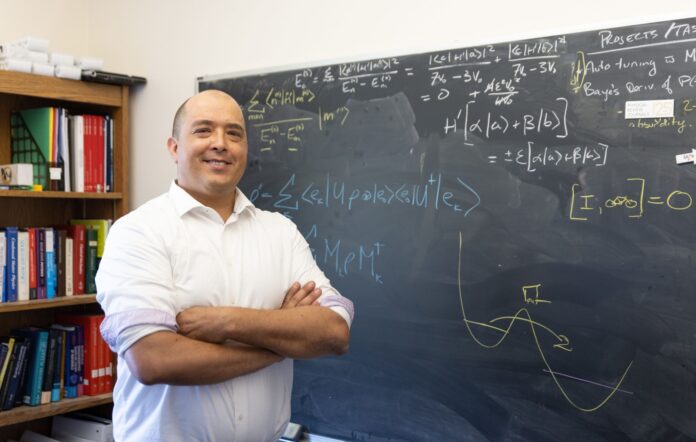Cal State San Marcos physics professor Justin Perron led a California State University-wide effort that has resulted in a grant of more than $2.5 million from the U.S. Department of Energy that will help develop a workforce capable of thriving in a quantum landscape.
Perron is the principal investigator for a three-year, $2,534,399 grant titled “QIST in the CSU: Expanding Access to Quantum Information Science and Technology.” The award is through the Reaching a New Energy Sciences Workforce (RENEW) program in the Department of Energy.
The emerging field of QIST aims to harness the power of quantum mechanics and usher in a radical new era of technology.
“Since the mid-20th century, we’ve had technologies that are enabled by our understanding of quantum mechanics – things like lasers and the transistor – which have revolutionized our economy and general way of life,” Perron said. “However, although enabled by our understanding of quantum mechanics, these technologies don’t generally use or rely on the more ‘weird’ aspects of the theory, things like entanglement or quantum measurement. We’re at a point now where we can engineer quantum systems well enough that we can control these aspects and potentially use them for practical applications.”
Proposed applications, Perron said, include such things as simulations, data encryption and information security – important components of U.S. scientific leadership, national security and economic competitiveness.
Perron worked on the grant proposal with fellow CSUSM physics professor Ed Price as well as representatives from the CSU Office of the Chancellor, Chico State and multiple external entities. The grant started this February and will continue through February 2026.
The grant project will utilize a two-pronged approach to broadening participation in the QIST field. The first is to focus on providing student opportunities and support. The planned methodologies are bridge programs to expose incoming undergraduate students to QIST and ensure that they have the math skills necessary to succeed in their college majors; cohort-based student learning communities that will provide professional development and community support to students interested in QIST; and summer internships through Sandia National Laboratories that will offer QIST research experiences that are rare at the undergraduate level because of the cost and complexity of QIST systems.
The bridge programs and student learning communities will take place at CSUSM and Chico State, and will be coordinated with the help of Growth Sector, a Bay Area nonprofit that seeks to expand access to STEM degrees and careers.
The second prong is to focus on faculty activities that will expand the capacity within the CSU system to offer QIST educational experiences. This will be accomplished through two annual summer workshops at CSUSM to train CSU faculty on QIST concepts and educational modules as well as faculty online learning communities (FOLCs) during the academic year to ensure that faculty persist in their implementation of QIST education.
STEM-NET, the CSU multicampus consortia at the Office of the Chancellor, will disseminate the tools developed through these activities and increase adoption of QIST curriculum across the entire system.
“I hope that the long-term impact of this project will be a strong QIST education community in the CSU that provides sustainable pathways for students to join the field,” Perron said. “I hope the result is that CSU students in STEM fields will be aware of what QIST is and have opportunities both in and out of the classroom to learn more about it, should they want to.”
The QIST project is an outgrowth of a different grant that Perron received more than two years ago – as part of a group with CSUSM physics professor Charles De Leone and math professor Shahed Sharif – from the American Physical Society Innovation Fund. Through that grant, the faculty trio hosted a workshop that aimed to identify the difficulties associated with incorporating QIST into the curriculum of predominantly undergraduate institutions.
“From discussions and follow-up activities associated with that, it became clear to me that there are a lot of like-minded faculty who would love to bring QIST to their students but are running into certain challenges,” Perron said. “This grant provides a lot of resources to overcome many of these barriers. The nature of QIST has so far limited most opportunities for undergraduates to engage with QIST to large research-focused institutions. I think this award will go a long way toward addressing that access issue and build capacity in undergraduate-focused institutions to bring this field to their students.”
About California State University San Marcos
Building on a 33-year history, California State University San Marcos is a forward-focused institution, dedicated to student success fueled by innovation, education and community partnerships. Located on a 306-acre hillside overlooking the City of San Marcos, it is the only public four-year comprehensive university serving North San Diego, Southwest Riverside and South Orange counties.
The university enrolls more than 16,000 students. It ranks among the national leaders in social mobility, increasing the opportunities and improving the life trajectories of underrepresented students. As a recipient of the annual HEED Award since 2014 — a national honor recognizing U.S. colleges and universities that demonstrate an outstanding commitment to diversity and inclusion — CSUSM is committed to creating a diverse and inclusive environment.


















